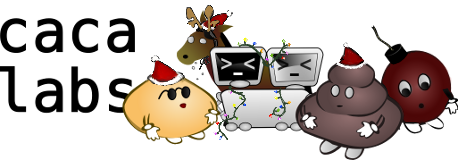A libcaca tutorial
First, a very simple working program, to check for basic libcaca functionalities.
#include <caca.h> int main(void) { caca_canvas_t *cv; caca_display_t *dp; caca_event_t ev; dp = caca_create_display(NULL); if(!dp) return 1; cv = caca_get_canvas(dp); caca_set_display_title(dp, "Hello!"); caca_set_color_ansi(cv, CACA_BLACK, CACA_WHITE); caca_put_str(cv, 0, 0, "This is a message"); caca_refresh_display(dp); caca_get_event(dp, CACA_EVENT_KEY_PRESS, &ev, -1); caca_free_display(dp); return 0; }
What does it do?
- Create a display. Physically, the display is either a window or a context in a terminal (ncurses, slang) or even the whole screen (VGA).
- Get the display's associated canvas. A canvas is the surface where everything happens: writing characters, sprites, strings, images... It is unavoidable. Here the size of the canvas is set by the display.
- Set the display's window name (only available in windowed displays, does nothing otherwise).
- Set the current canvas colours to black background and white foreground.
- Write the string
"This is a message"onto the canvas, using the current colour pair. - Refresh the display, causing the text to be effectively displayed.
- Wait for an event of type
CACA_EVENT_KEY_PRESS. - Free the display (release memory). Since it was created together with the display, the canvas will be automatically freed as well.
You can then compile this code on an UNIX-like system using the following commans (requiring pkg-config and gcc):
gcc `pkg-config --libs --cflags caca` example.c -o example
